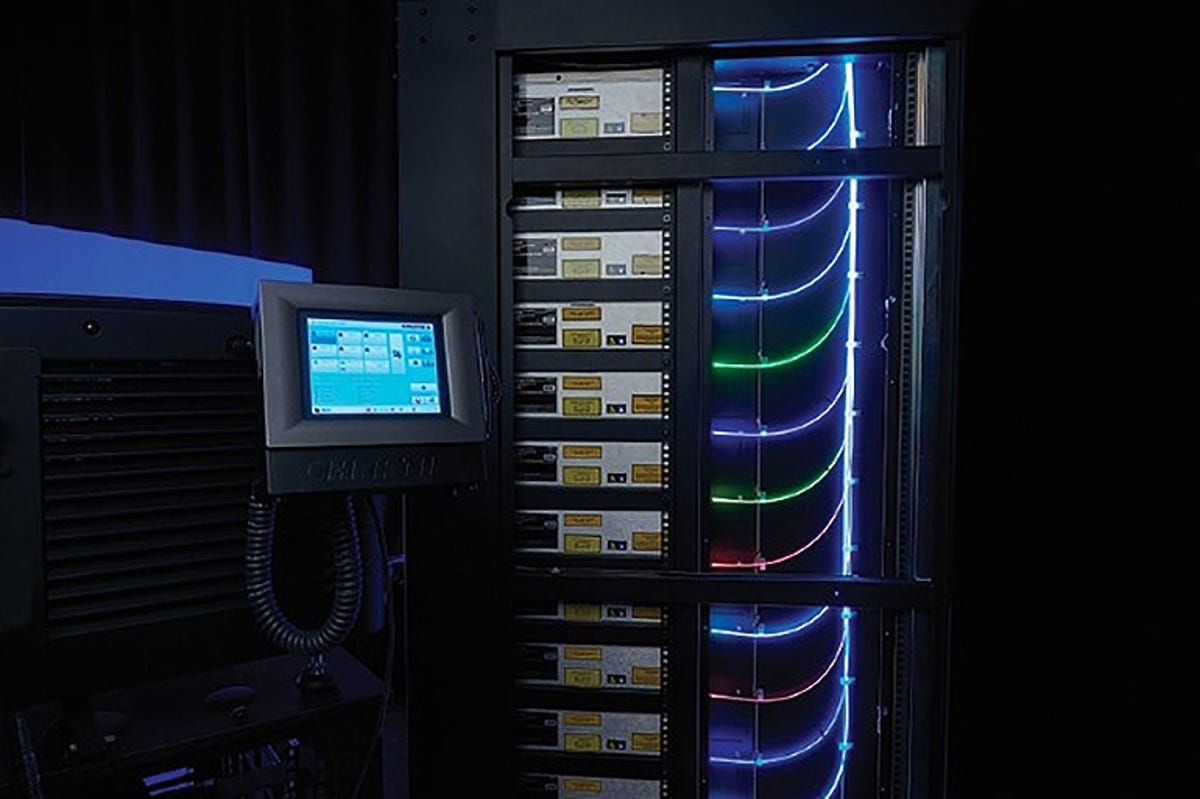
Christie
Projectors are starting to use lasers to generate light. What was once the realm of science fiction, or at least the nemesis of cats and Professor Hathaway, is now being used to create some of the best big-screen images possible.
Beyond picture quality, lasers last longer than traditional projector lamps, aren’t as fragile, and offer nearly instant on/off. With these benefits, lasers will probably be the future of front projection.
Projectors provide the biggest, most immersive images you can see. Sure, you can buy a 70-inch TV today, but projection screens in the home are usually 100 inches or more in size, and that much more amazing to experience in person. In theaters, the sheer size of the screen is one of the best reasons to pay for going to the movies. When I saw
in one of the best theaters in the world, it blew me away. That image was powered by lasers, and lasers can make your big-screen experience better too.
Goodbye Xenon, hello Lazlo
As awesomely futuristic as they sound, laser projectors aren’t that much different from traditional projectors. With all projectors, something creates light, and that light is then manipulated to create the image on the screen. The only thing changes with laser projectors is what is creating the light.
In the purest form, red, green and blue lasers are “defocused” to fill an entire DLP, LCOS, or LCD chip. The lasers don’t scan the chip (or the screen). So, in fairness, “laser projector” is about as much of a misnomer as “LED TV.” Both terms refer to the of name the technology that creates the light — lasers and light-emitting diodes, respectively — not the technology that creates the image as a whole. “DLP projector” and “LCD TV” would be more accurate.
Lasers replace the UHP, Xenon, and other lamps found in current projectors. So even though that makes “laser projectors” a little less futuristic (more evolution than revolution), they’re still way cool, and offer lots of benefits.
All about the B (and R and G)
There are several benefits of lasers, and they’re all tied together. The first is efficiency. If you read my Ultra HD Color, Part I article, you’ll remember that TVs and projector use red, green and blue light to create every color you see on the screen.
A normal projector lamp creates white light. This may seem like a good thing, but the fact is, projectors have to throw away (absorb or otherwise block) most of this light, leaving only the red, green, and blue parts. It then projects those on the screen so you can see — wait for it — white light. Mildly inefficient, that.
Lasers only create the exact colors needed, which uses less power. Here’s one way to think about it: if a UHP lamp draws 300 watts to create white light, only a portion of that is used to create red, green and blue. The rest is wasted on yellow, purple, chartreuse, etc. With a laser projector there could be three 100-watt lasers which could, in theory, each create much more light for their respective colors, given the same overall power draw. It’s not quite this simple, but that’s the basic advantage.
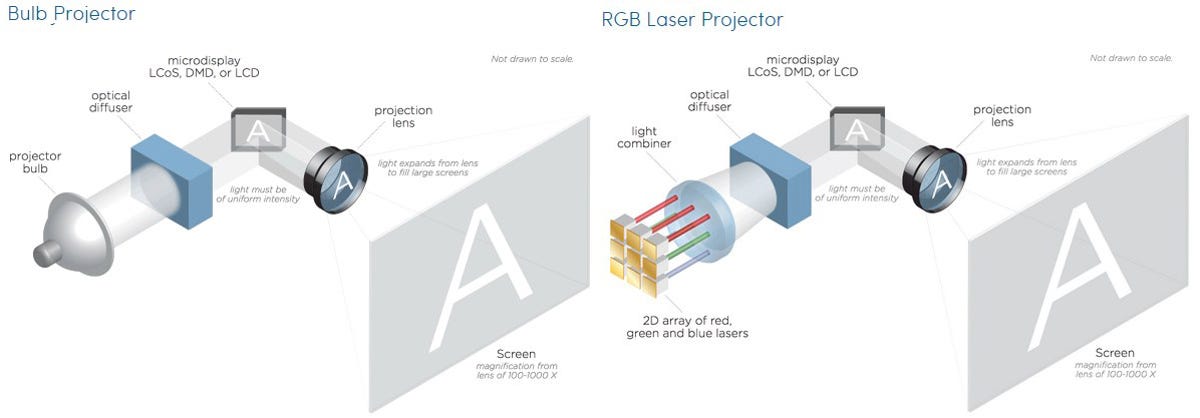

Laser Illuminated Projector Association
And turns out that efficiency does mean laser projection systems can get brighter. Muchbrighter. When I saw “Tomorrowland,” Dolby claimed they were getting 31 foot-Lamberts off the screen, which is similar to what many plasma TVs could do. In a dark room with a massive screen, 31 fL is incredibly bright. It’s highly unlikely you’d be able to get that amount of light with a traditional lamp without requiring a power sub-station and a cryogenic deep-freeze.
Perhaps most interesting, lasers can be built to create whatever wavelength of light you want (within reason, of course). So wider color gamuts are possible without brightness issues. That translates to deeper, richer colors that come closer than ever to the vast range of colors our eyes can appreciate. The version of “Tomorrowland” I watched used the P3 color gamut, widely considered the next level of color for future home video sources like 4K Blu-ray. Dolby says their laser projection technology can handle all the way out to the Rec 2020 color space, which is really huge.
There are also benefits like fast (or possibly instant) on/off. As any projector owner can tell you, not having to wait around for the projector to warm up or cool down is awesome. This fast adjustment in output also means a huge dynamic contrast ratio potential, essentially turning the lasers off (or down) during dark scenes.
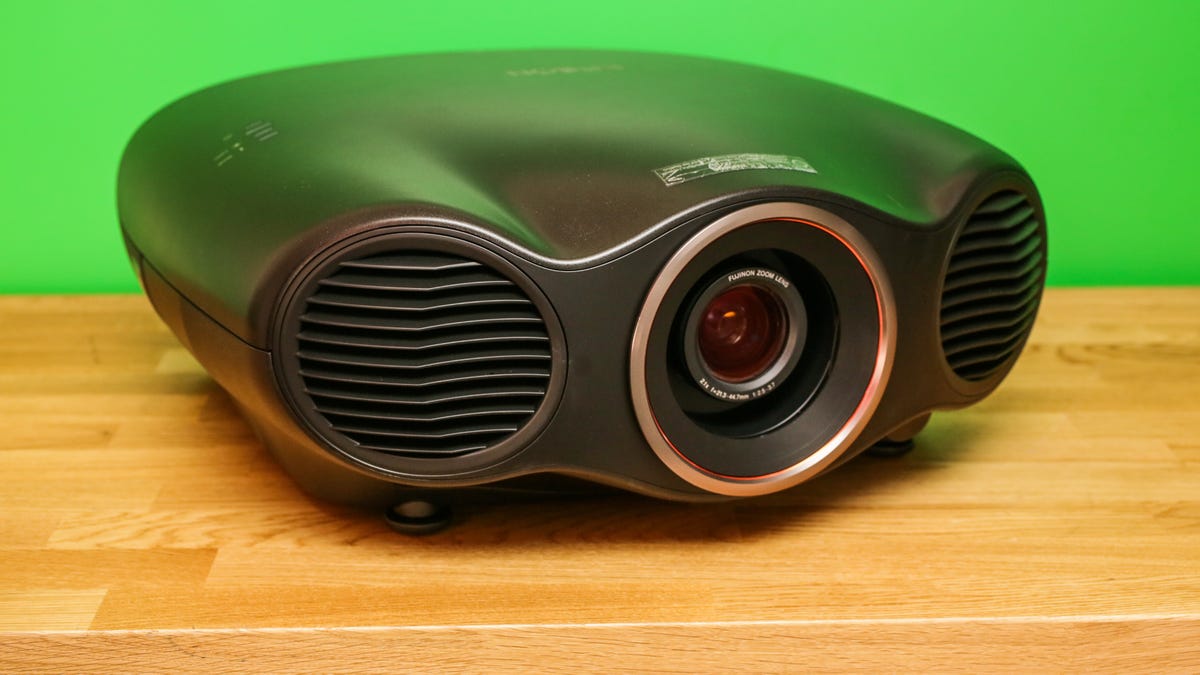

Sarah Tew/CNET
Lastly, there’s longevity. Epson, for example, is claiming 30,000 hours for the lasers in the LS10000 , one of the best laser projectors currently available for home theater in the US. Compare this to the roughly 3,000 hours most home projectors get with their UHP lamps. At $250 to $400 per lamp over the lifetime of the projector, that’s some serious savings.
Safety and speckle
There are two common questions when it comes to lasers. The first is one of safety. After all, anyone who’s played with a consumer laser knows you don’t shine them in people’s eyes.
The lasers in projectors are much more powerful. Doesn’t that mean they’re more dangerous?
Epson says safety is not an issue. “The laser passes through a phosphor/diffuser wheel. Light from the projection lens complies with the class 2 safety standard, and is in accordance with other laser projectors. There is no risk of retina damage, unless users intentionally stare into the lens directly for prolonged periods.”
Christie, another company that makes laser projectors, adds that “high-powered laser projectors are no more dangerous than other lamp-based, high-brightness projection systems.”
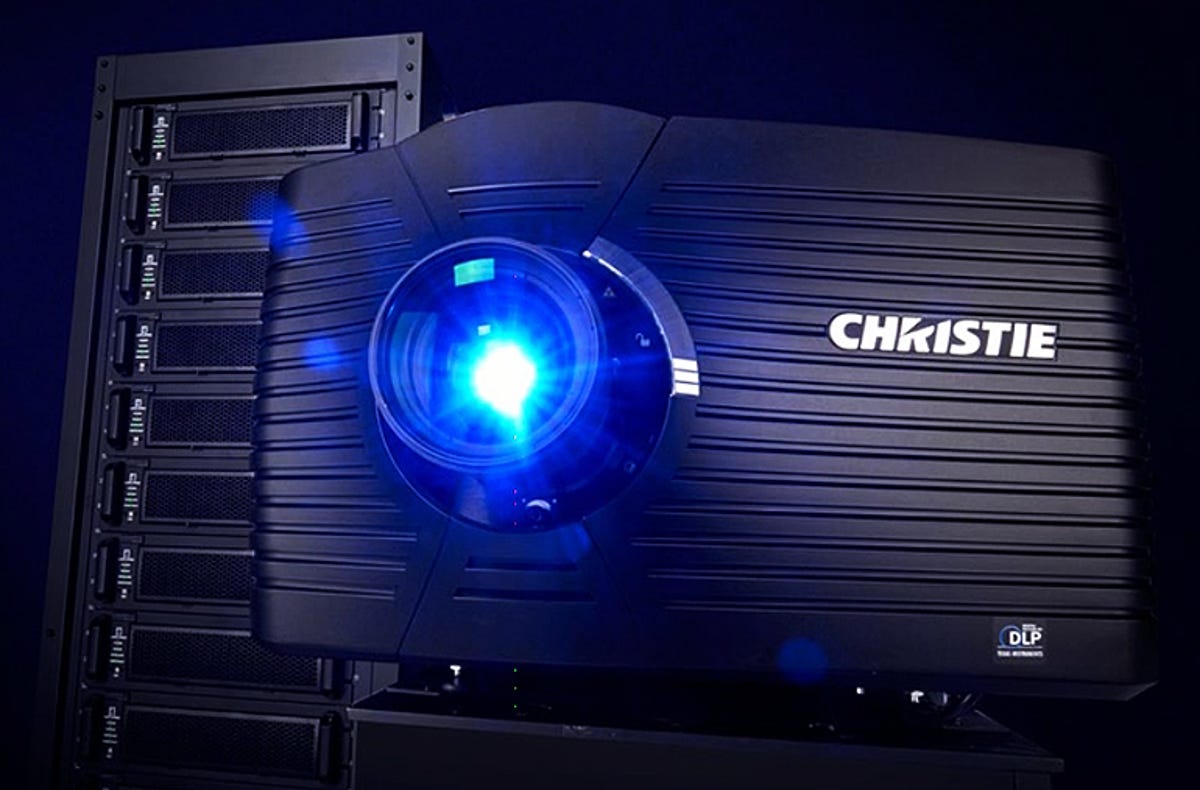

Christie
The fact is, by the time the light leaves the lens (actually, well before that), it’s no longer a coherent beam. So it’s still bright, but not focused. It’d be no worse than staring at any seriously bright light (which, to be fair, isn’t a, ahem, bright idea anyway).
There are some FDA requirements for the cinema projectors, based on the fact that those laser projectors are classified as a “laser light show.”
Another question concerns sparkle, or speckle. If you’ve ever shone a laser on a reflective surface (even a white wall), you’ve probably seen the speckle. It is the sparkly bits in the overall reflected light.
There are a number of factors that contribute to speckle, but for the most part it’s unlikely you’ll see it with most laser projectors. For example, Epson says it’s not an issue with their LS10000 projector. The Laser Illuminated Projector Association (LIPA) acknowledges it could be a problem, but says “researchers have developed very effective means of virtually eliminating any visible speckle in state-of-the-art laser illuminated projector systems .”
I certainly didn’t see anything during “Tomorrowland“ and CNET Editor David Katzmaier didn’t either when he reviewed Epson’s LS10000.
Hybrids: Fewer lasers, lower prices
At home and in the cinema, there are hybrid designs that don’t use all three colors of separate red, green and blue lasers. Instead, they use one or two of those, and then some method with phosphors to create the other wavelengths of light. One benefit is to cut costs.
The Epson LS10000 uses a hybrid design with two blue lasers: One for blue light, the other to energize a yellow phosphor, which splits the blue light into red and green.
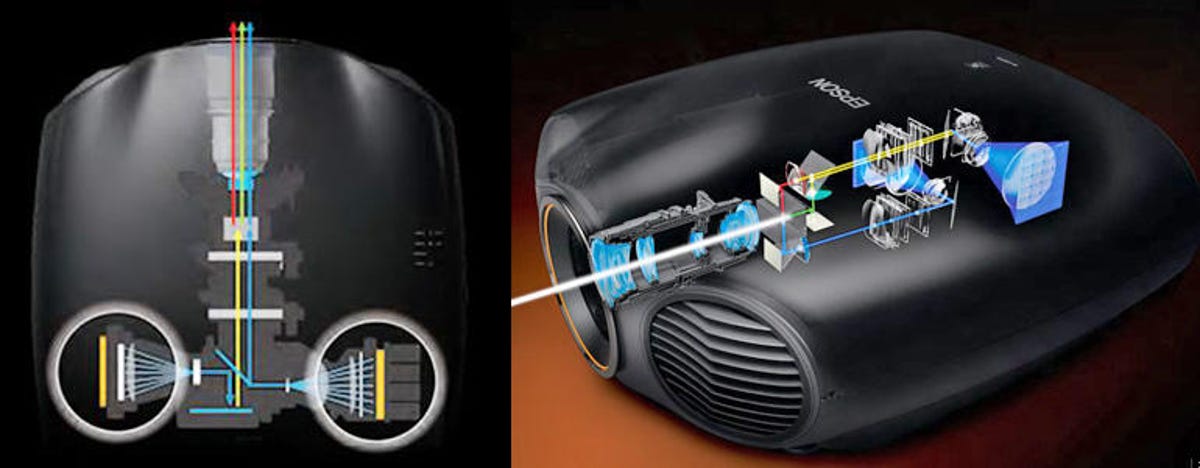

Epson
Epson’s Product Manager Brian Savarese explained things further. “The dual blue-laser sources in Epson Pro Cinema LS models have different characteristics. One is to achieve higher color space coverage, while the other is focused on brightness (a high-efficiency laser system). Additionally, Epson is committed to bringing new technology at a competitive price for the discerning home theater customer. Currently, the laser light source architecture achieves this goal, delivering a new Epson Pro Cinema experience at an optimal price point.”
In case you’re wondering, the LS10000 costs $7,999 in the US (its equivalent in the UK is the EH-LS10000 for £5,999) while the similarly laser-powered LS9600e goes for $5,999. Numerous less-expensive laser projectors are also available for home and business use, but none we’ve seen offer the kind of performance that the Epson does.
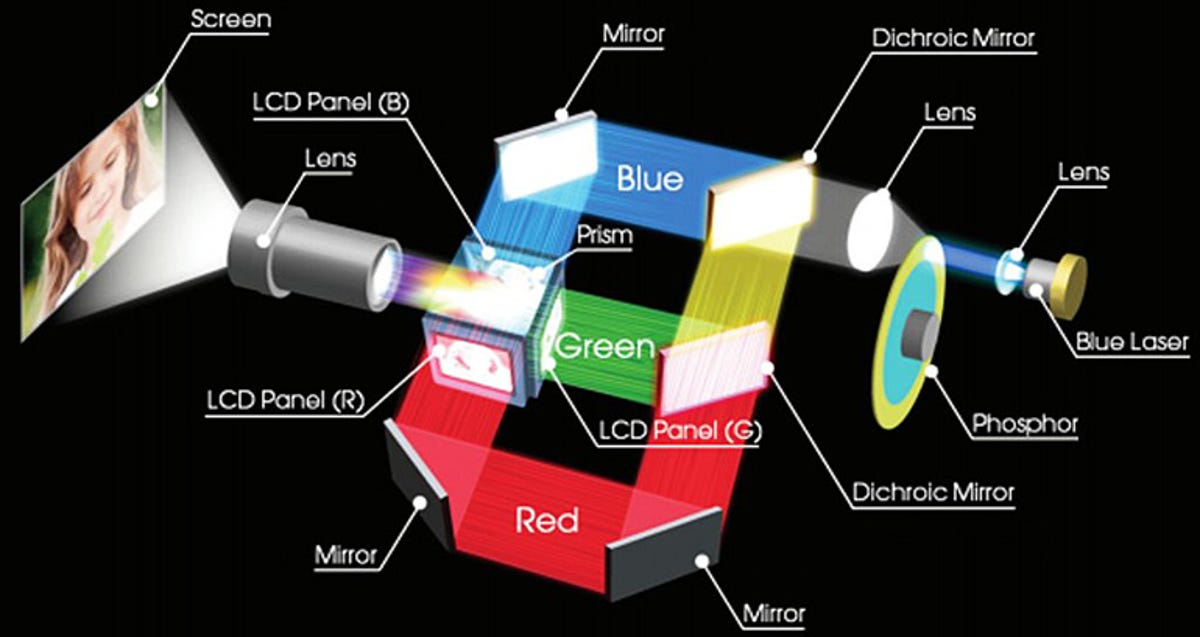

Sony
Sony, Casio, and several other companies have laser-hybrid designs, sometimes with just a laser and phosphors, other times with lasers, LEDs, and phosphors. For the most part these are found on business or industrial projectors (like digital signage). Christie has some cinema projectors that use a hybrid designs too.
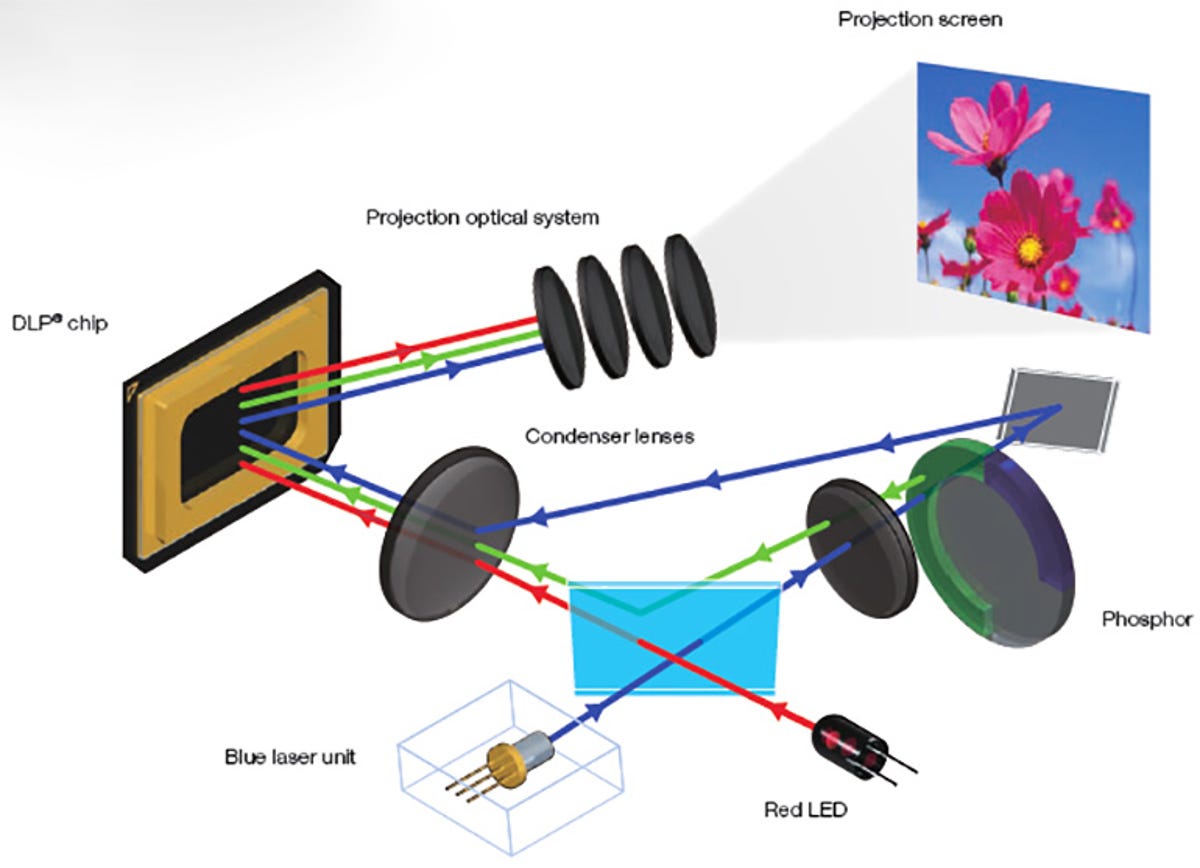

Casio
Bottom Line
The short version? Lasers offer potentially brighter projected images, with more and better colors. They’re expensive right now, but hopefully we’ll see cheaper high-performance theater models soon.
Lasers, once again, are the future.
Got a question for Geoff? First, check out all the other articles he’s written on topics such as why all HDMI cables are the same, LED LCD vs. OLED vs. Plasma, why 4K TVs aren’t worth it and more. Still have a question? Send him an email! He won’t tell you what TV to buy, but he might use your letter in a future article. You can also send him a message on Twitter @TechWriterGeoff or Google+.




